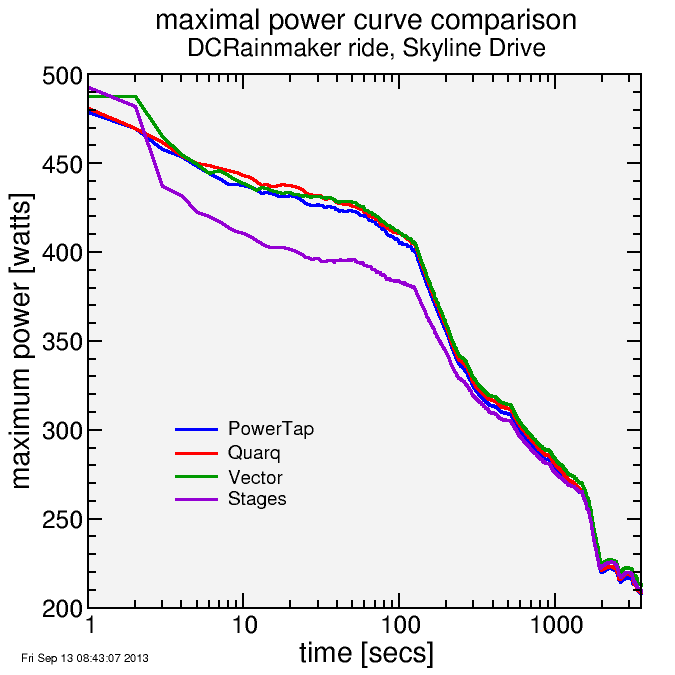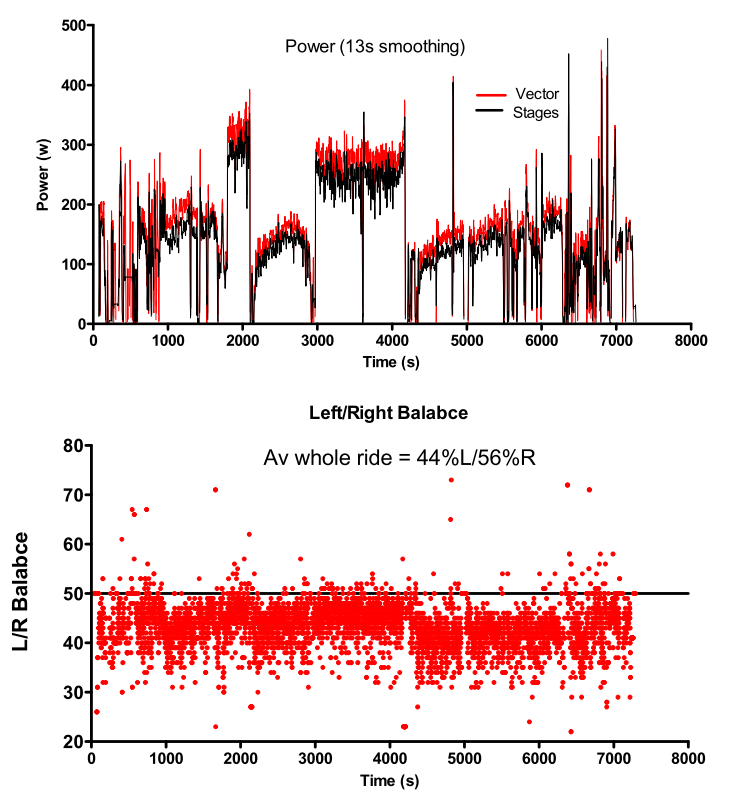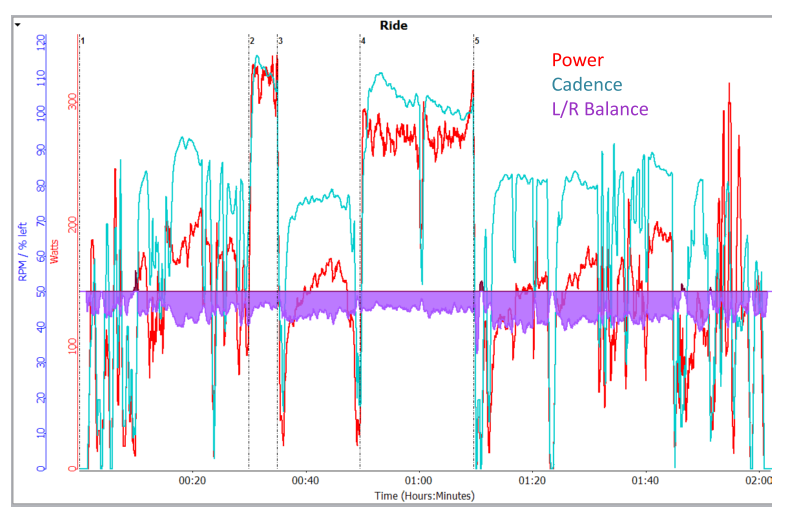Stages power meter
Comments
-
stoobydale wrote:
<snip> I was aware of the Stages assumption of doubling the LHS to give a total output. But from initial reviews it seems that this is not really an issue as the figures are repeatable. Wich surely is the main thing at this price point.Stages measures the torque applied to the left crank with a strain gauge on the left crank arm, and the rotational velocity (once per revolution) of the left crank arm using accelerometer. This is used to calculate a left side crank power value.
Stages then assumes the total power = 2 x the left side measured power
Not sure what you mean by repeatable?
That's the problem, you can't know since asymmetry in power production is normal, variable depending on various factors and changeable. Whether or not the level of uncertainty in such a means of power measurement matters to an individual depends on what they intend to use the data for.stoobydale wrote:My answer was not worded very well. I was more referring to the spider based power meters not actually measuring the left hand side power but interpolating the torque applied to the right hand gauges via the bottom bracket and left hand side crank arm.
Well since the spider is downstream of the cranks, it cannot distinguish which side is delivering the torque but it is most definitely measuring the (net) torque applied from both sides and most definitely doesn't interpolate anything, so let me explain.
It's all a matter of what one defines as measuring left and right side power, since it's not actually something that's well defined.
Is it the power delivered by each leg, or power delivered via each crank, or power for each half of the pedal stroke? Because each of those will be different yet each can easily be referred to as left and right. There's no correct answer, and so one needs to know what specifically they are interested in and why.
What spider based power meters that provide a left/right value do is to provide the proportion of power (well torque really as velocity is only measured once per revolution) for each half of the pedal stroke, where left is the total of the torque applied to the spider when the left crank arm is forward of centre of the BB (and right for when right crank arm is forward of centre of BB) but of course that's actually measuring the net torque applied to both cranks during that half of the pedal stroke. IOW it does not distinguish downstroke from upstroke on opposite crank, it's just giving you total/net torque for that half the pedal stroke.
What crank based power meters that measure each side independently do, of course, is measure the torque applied to each side independently. However keep in mind that there is still a net effect being measured on each side since the cranks are still a coupled system.
To calculate total power from independent crank measurement, the torque vectors have to be summed. e,g, the left downstroke side might be 100 torque units and the upstroke side might be -5 units, giving a net torque of 95 units (which would be the value the spider method above provides). On the right down stroke side it might be +95 for the downstroke and +3 units for the upstroke, for a net torque of 98 units. Total net torque = 95+98 (or 100 - 5 + 95 + 3) = 193 units.
So is left right split 95:98? Or is it 100:95? or is it something else? See the problem.
So yes, both of those methods of indicating left and right side power are different and hence why much care should be made in how to interpret such things. Both are a gimmick at this stage IMO, since neither is providing actionable intelligence to guide training intervention for improved performance. Indeed I'd suggest they may even mislead some to consider a training intervention that's neither warranted nor appropriate.0 -
and to further add, I'm not even convinced it's useful as a means to measure recovery from single leg injury, partly due to the measurement anomalies I highlighted above but also because it really doesn't matter that much, since it's total power output that dictates your performance.0
-
Stages don't require you to have the exact matching chainset, for example you could use a 105 crank arm on Ultegra or Dura-Ace, or vice-versa. Likewise with Sram road chainsets.
The MTB versions are a slightly different matter.0 -
mattclinton wrote:Stages don't require you to have the exact matching chainset, for example you could use a 105 crank arm on Ultegra or Dura-Ace, or vice-versa. Likewise with Sram road chainsets.
Ghetto fabulous.English Cycles V3 | Cervelo P5 | Cervelo T4 | Trek Domane Koppenberg0 -
Tempted with the track version...
Except! can see issues with measuring standing starts.Insta: ATEnduranceCoaching
ABCC Cycling Coach0 -
The Stages has the ability to measure at a much higher rate than most of the other PM's out there, you can even when using Bluetooth Smart send 4x data packets a second from the unit. The resolution for this has also been designed for the BMX cranks so shouldn't offer any issues with the standing starts, the accelerometer activates every 30degrees (12 per rotation) and only displays cadence when there's torque applied to the crank.0
-
Hmmm. Interesting. It's just that it'll discount the second (right leg) revolution power reading as you set off though? Plus, it only measures up to 1999w.
Meh, who am I kidding, it'll be fine! :OInsta: ATEnduranceCoaching
ABCC Cycling Coach0 -
I have to laugh when people jump to Stages defence by saying that spider-based power meters like P2M, SRM, Quark etc only measure power from the right leg.
 I think if you lack the basic understanding of how a crank drives a bike forwards, then using a power meter may be a bit too complicated for you. CAPTAIN BUCKFAST'S CYCLING TIPS - GUARANTEED TO WORK! 1 OUT OF 10 RACING CYCLISTS AGREE!0
I think if you lack the basic understanding of how a crank drives a bike forwards, then using a power meter may be a bit too complicated for you. CAPTAIN BUCKFAST'S CYCLING TIPS - GUARANTEED TO WORK! 1 OUT OF 10 RACING CYCLISTS AGREE!0 -
Well they only recently managed to sort out measurement of crank rotational speed once per revolution without considerable noise/error, so I'll be interested to see how well they can measure it 12 times per revolution.mattclinton wrote:The Stages has the ability to measure at a much higher rate than most of the other PM's out there, you can even when using Bluetooth Smart send 4x data packets a second from the unit. The resolution for this has also been designed for the BMX cranks so shouldn't offer any issues with the standing starts, the accelerometer activates every 30degrees (12 per rotation) and only displays cadence when there's torque applied to the crank.
Don't confuse the data packet rate with better power resolution.
Also, the issue with Stages isn't accuracy of left crank measurement, which can be as perfectly precise and accurate as it likes but while ever it only ever measures the left crank, it can only ever provide an estimate of total power output with an unknown and variable error. As I've said before, it's then a matter of whether that level of unknown and variable error matters to the individual.0 -
Short duration power measurement is possibly the weakest element of the Stages approach to power measurement. Here's an individual example:NapoleonD wrote:Hmmm. Interesting. It's just that it'll discount the second (right leg) revolution power reading as you set off though? Plus, it only measures up to 1999w.
Meh, who am I kidding, it'll be fine! :O 0
0 -
-
Does anyone know if they'll ever do Rotor and Campag versions?Selling my Legend frame
http://owningalegend.wordpress.com/2014 ... ced-price/0 -
LegendLust wrote:Does anyone know if they'll ever do Rotor and Campag versions?
They've been looking at Rotor, but there's issues with the shape of the crank arm, so whether one will ever appear on the market is anyone's guess.
As for Campag, I'm sure that's more likely, though it will only be in alloy versions.0 -
Are they all for you Matt, or do you have buyers? If you are a seller, what type is in most demand?0
-
stoobydale wrote:Are they all for you Matt, or do you have buyers? If you are a seller, what type is in most demand?
Matt works at Cyclepowermeters.com!Insta: ATEnduranceCoaching
ABCC Cycling Coach0 -
NapoleonD wrote:
Matt works at Cyclepowermeters.com!
Ahh, must be ok if they are going to start selling, supporting them. Will check out the website.0 -
stoobydale wrote:NapoleonD wrote:
Matt works at Cyclepowermeters.com!
Ahh, must be ok if they are going to start selling, supporting them. Will check out the website.
They're selling them because they think they can make money on them. Neither Stages nor Cyclepowermeters can account for your pedalling asymmetry.More problems but still living....0 -
amaferanga wrote:They're selling them because they think they can make money on them. Neither Stages nor Cyclepowermeters can account for your pedalling asymmetry.
??? Who said I have pedalling asymmetry? :?0 -
Who doesn't?25% off your first MyProtein order: sign up via https://www.myprotein.com/referrals.lis ... EE-R29Y&li or use my referral code LEE-R29Y0
-
So maybe it's not the tool to choose for aero testing and other precise applications but for users wanting to train to power by keeping within zones which typically span 20W then surely this is a useful product?0
-
jon208 wrote:So maybe it's not the tool to choose for aero testing and other precise applications but for users wanting to train to power by keeping within zones which typically span 20W then surely this is a useful product?
But its not much cheaper than a powertap or power2max, which will both give reliable data. Pedalling L/R balance can vary with fatigue state, cadence, power output, etc. so with Stages you'll never know how much error there is in the data.
Only £650 for a Power2max sensor only vs. £599 for the cheapest Stages - it really should be a no-brainer.More problems but still living....0 -
Fair point.0
-
I'll be doing some testing to compare with a Quarq and/or Powertap as soon as I get a chance. By all accounts DC Rainmaker has posted some very favorable reviews.
I'm still not quite sure what having left/right power actually gains you, having a set of Rotor Power on one bike and I've completely ignored this metric! At the end of the day it's total power that propels you forward.0 -
mattclinton wrote:I'll be doing some testing to compare with a Quarq and/or Powertap as soon as I get a chance. By all accounts DC Rainmaker has posted some very favorable reviews.
I'm still not quite sure what having left/right power actually gains you, having a set of Rotor Power on one bike and I've completely ignored this metric! At the end of the day it's total power that propels you forward.
I agree that having L/R balance isn't really useful, but the problem with Stages is it only measures left leg power.More problems but still living....0 -
amaferanga wrote:I agree that having L/R balance isn't really useful, but the problem with Stages is it only measures left leg power.
That is true, working on the assumption they're both the same. Apparently this is fine for the vast majority of people, where consistency in the meter is the key, not the pure accuracy.
In the real world I've been told for most people it's within a couple of watts of an SRM anyway....0 -
mattclinton wrote:amaferanga wrote:I agree that having L/R balance isn't really useful, but the problem with Stages is it only measures left leg power.
That is true, working on the assumption they're both the same. Apparently this is fine for the vast majority of people, where consistency in the meter is the key, not the pure accuracy.
In the real world I've been told for most people it's within a couple of watts of an SRM anyway....
But it won't be consistent since for many people (most?) L/R balance will vary through a ride and will depend on fatigue levels, cadence, power output, etc. According to my P2M my L/R balance over the course of a ride is usually close to 50/50 but for segments and intervals it's often far from 50/50.
I can see that if all you look at is the average power over a whole ride then it'd be quite easy to convince yourself that Stages is good enough, but if you look more closely you'll see significant errors in power (much bigger than you'd see with other power meters that cost around the same).More problems but still living....0 -
Just to do the math on this then .. if Stages reads 300W then it's reading 150W from your left leg. So, if you are putting out 55%L/45%R, then 150W=55%, so 100% power is 150/55*100 = 272.73W? A significant difference.
Is 55/45 a typical imbalance, I'd guess some individuals could be even further out?
Even 51/49 would mean actual power would be 294.1W at an indicated 300W.
Of course, if your right leg is more powerful then buy one, you'll be pleasantly surprised at your performance level when Stages is telling you that you are a noodle-legged phaggot.All the above is just advice .. you can do whatever the f*ck you wana do!
Bike Radar Strava Club
The Northern Ireland Thread0 -
In the real world, asymmetry is variable depending on a range of factors and as a result they will rarely be consistent with power meters that account for both legs, no matter how accurately they measure the left side.mattclinton wrote:amaferanga wrote:I agree that having L/R balance isn't really useful, but the problem with Stages is it only measures left leg power.
That is true, working on the assumption they're both the same. Apparently this is fine for the vast majority of people, where consistency in the meter is the key, not the pure accuracy.
In the real world I've been told for most people it's within a couple of watts of an SRM anyway....
Here's an example posted by someone the other day from their ride with both Vector and Stages:
and the Vector data specifically:
I can see a few things in this individual example:
- asymmetry in power production varies quite a bit (that's already well established in the published science)
- in general, as this rider fatigued their asymmetry increased
- in general, as they rode at higher sustained power their asymmetry declined
In this ride, his overall average L-R was 44%-56% and the Stages reported a power output ~12% less than the Vector measuring both legs.
As you can see, this rider will not get consistency in power data relying on Stages alone.
YMMV0 -
So I have my SRM on the bike and the Stages PM is arriving today. Anyone think of a good test (either road or turbo) to check the respective watts ?
Stages PM arrived yesterday. It is going to be a very easy piece of kit to move between bikes, which will be very useful to me. Battery changes will be simple and the unit seems incredibly easy to set up and match with a Garmin 500. Will probably now try it out alongside the SRM on some long rides and some climbs to test how closely the power files match.0 -
Did my first ride on the turbo/trainerroad yesterday with the stages. It's my first and only power meter so nothing to compare it against. Appreciate it's not going to be truly accurate but will be fine enough for what I need.
Seriously considered the power2max but already have SRAM Red and Force cranks and didn't want to have to buy another, plus rings. Whilst swapping a crank isn't the end of the world it's far easier to swap just the one arm between my bikes.0


